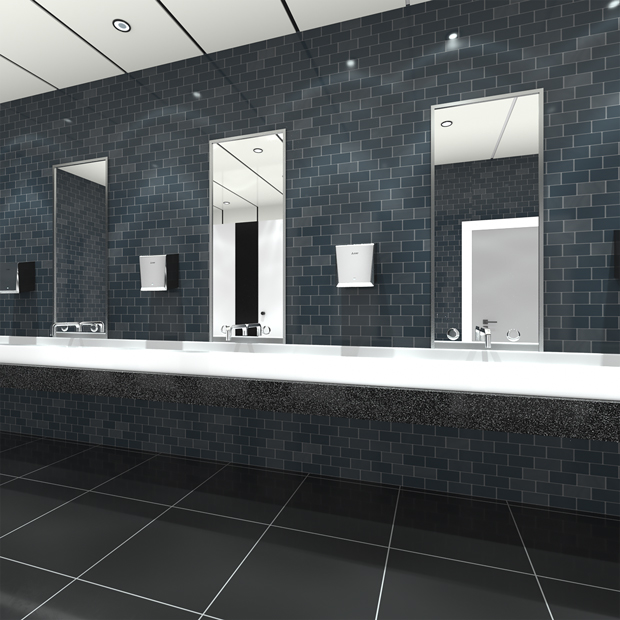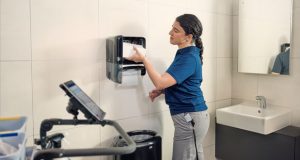With a National Toilet Day celebrated since 1985 and a high-tech bathroom gallery at Tokyo’s Narita International Airport – it’s safe to say that people in Japan take their bathrooms seriously. The country is also famous for its smart washroom environments, which are designed to help users defeat toilet anxiety. Especially in public spaces, it can be challenging to deliver maximum comfort and hygiene, so what can we learn from the Japanese approach to creating inviting washrooms?

Mitsubishi Electric’s hand dryers help create a pleasant working and studying space whilst contributing to optimising the building’s energy efficiency [Image © Mitsubishi Electric Europe B.V.]
Not only do Japan’s train stations, parks and public spaces generally have spotless restrooms, but these are also filled with next-generation appliances and devices. Of course, there is no toilet like home, but a Japanese restroom comes pretty close. Laura Cayless, Business Development Manager at Mitsubishi Electric, looks at four core washroom principles and technologies from Japan – the company’s home country.
1. A deep-rooted history of cleanliness
In Japan, there are longstanding traditions centred around purity and cleanliness. One of them is linked to Shintoism – the country’s native faith. It promotes many rituals for purifying people, places and objects of ‘kegare’. This term indicates a withering of the spirit, but it literally translates to ‘uncleanliness’ or ‘defilement’ and refers to both metaphysical and physical impurities. Therefore, it makes perfect sense that Japan’s toilet culture and technology is fully geared towards creating clean environments.
2. Advanced bathroom comforts
To ensure a comfortable washroom experience, it makes sense to start by removing any nuisances. Whether this means an unpleasant smell, a dirty surface or an awkward sound – Japanese bathroom designers will have thought of a clever way to get rid of these sources of irritation. While they were at it, they will have probably also added a few comforts on top.
For example, most Japanese toilets lift their seats and flush automatically, without the need to touch their surfaces. They also come with electronic bidets, deodorisers, seat warmers as well as sound systems to cover up embarrassing noises.
3. Adding restroom conveniences
Japanese bathrooms don’t just excel at comfort, they also go above and beyond when it comes to added conveniences. For example, some bathrooms have dedicated seats for babies while parents use the facilities. Others have flip-down boards that people can stand on while they get changed to protect socks and other pieces of clothing from any dirt on the bathroom floor.
Special hooks for bags and umbrellas are installed to create storage space and to facilitate thorough, hygienic hand washing. In addition, accessible stalls with handrails are commonplace to support Japan’s rapidly aging society. Last but not least, some motorway services have toilets that can measure a user’s fatigue levels and provide advice on how often drivers should take a break during long trips.
4. Ensure maximum (hand) hygiene
Hygiene is quite possibly the biggest factor in influencing what is considered a pleasant bathroom experience. While washing one’s hands is key to this, knowing how to avoid spreading germs by drying your hands effectively is equally important.
By far the most hygienic solutions are blade or jet air automatic hand dryers, with hands-in models, such as Mitsubishi Electric’s Wave-i01, the norm in most public spaces in Japan. These are designed to dry hands in a very precise manner, watch the video here. Where many other hand dryers scatter droplets around the washroom, the Wave-i01 uses Mitsubishi Electric’s WaveTM nozzle technology to make sure water droplets are contained in its enclosed Excess Water Pod.
The latest evidence to prove the hygienic performance of hand dryers comes from a study commissioned by the Japan Business Federation, also known as Keidanren, for the Hygiene & Microbiology Research Centre in Tokyo. The research was conducted to evaluate the risk of Coronavirus circulating in washrooms and it concluded that hand dryers do not spread infections. Even more, Mitsubishi Electric’s assessment on the antimicrobial performance of its air-curtain hand dryers proved optimum bacterial removal and drying efficiency while slashing the potential for bacterial transfer.
Which of these points will you implement?
While all of the above mentioned washroom appliances and devices may not be widely available in the UK, we can still apply the key technologies and principles found in Japan to our public toilets. Bathrooms designed using ‘kerage’-driven approaches could well find their way into our lives in the near future but in the meantime, jet air hand dryers, such as the Wave-i01, can help to improve hygiene in public spaces.




